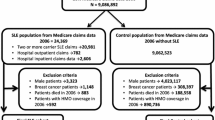Abstract
Purpose
The association between infectious mononucleosis (IM) and risk of breast cancer is unclear; no prospective studies have examined this relationship. We examined self-reported history and age at IM in relation to risk of invasive breast cancer.
Methods
Self-reported history and age at IM were examined in relation to risk of invasive breast cancer in a large cohort of women, the Nurses’ Health Study II (81,807 women followed from 1989 to 2007). Through questionnaires, women were asked whether they ever had IM and if so, at what age. During follow-up, 2,349 cases of invasive breast cancer were documented. Cox proportional hazards regression was used to estimate relative risks (RR) and 95 % confidence intervals (CI) for the association of IM with breast cancer.
Results
The multivariable-adjusted RR for history of IM and risk of invasive breast cancer was 1.00 (95 % CI: 0.90–1.11). Similar null results were obtained when estrogen receptor/progesterone receptor positive and negative tumors were considered separately. There were no clear patterns of association between age at IM and risk of breast cancer: compared to women with no history of IM, those who were ≤15 years old when they had IM were at lower risk (RR: 0.77; 95 % CI: 0.60, 0.97), but there was no association for women who had IM at ages 16–19, 20–24, or 30+. However, an increased RR (1.45; 95 % CI: 1.02–2.04) was observed for women who had IM at ages 25–29.
Conclusion
Results of this large prospective study do not support a clear association between history of clinical IM and risk of invasive breast cancer.
Similar content being viewed by others
References
National Cancer Institute. National Institutes of Health, estimated new cases and deaths (2012). http://www.cancer.gov/cancertopics/types/breast. Accessed 13 Sept 2012
The National Comprehensive Cancer Network (2006) Journal of the National Comprehensive Cancer Network.Vol 4 (Suppl 1). http://www.nccn.org/JNCCN/PDF/AdjuvantBreast2006.pdf. Accessed 1 Sept 2012
Amarante MK, Watanabe MA (2009) The possible involvement of virus in breast cancer. J Cancer Res Clin Oncol 135:329–337
Mant C, Hodgson S, Hobday R, D’Arrigo C, Cason J (2004) A viral aetiology for breast cancer: time to re-examine the postulate. Intervirology 47:2–13
Lawson JS, Gunzburg WH, Whitaker NJ (2006) Viruses and human breast cancer. Future Microbiol 1:33–51
Evans AS (1971) The spectrum of infections with Epstein-Barr virus: a hypothesis. J Infect Dis 124:330–337
Rickinson AB, Kieff E (1996) Epstein-Barr virus. In: Fields BN, Knipe DM, Howley PM (eds) Fields virology, 3rd edn. Lippincott-Raven Publishers, Philadelphia, pp 2397–2446
Niederman JC, Evans AS (1997) Epstein-Barr Virus. In: Evans AS, Kaslow RA (eds) Viral infections of humans: epidemiology and control, 4th edn. Plenum Medical Book Company, New York, pp 253–283
Fleisher GR (1984) Epstein-Barr virus. In: Belshe BB (ed) Textbook of human virology. PSG, Littleton, pp 853–886
Niedobitek G, Meru N, Delecluse HJ (2001) Epstein-Barr virus infection and human malignancies. Int J Exp Pathol 82:149–170
Huo Q, Zhang N, Yang Q (2012) Epstein-Barr virus infection and sporadic breast cancer risk: a meta-analysis. PLoS ONE 7:e31656
Bonnet M, Guinebretiere JM, Kremmer E et al (1999) Detection of Epstein-Barr virus in invasive breast cancers. J Natl Cancer Inst 91:1376–1381
Labrecque LG, Barnes DM, Fentiman IS, Griffin BE (1995) Epstein-Barr virus in epithelial cell tumors: a breast cancer study. Cancer Res 55:39–45
Herrmann K, Niedobitek G (2003) Lack of evidence for an association of Epstein-Barr virus infection with breast carcinoma. Breast Cancer Res 5:R13–R17
Michelow P, Wright C, Pantanowitz L (2012) A review of the cytomorphology of Epstein-Barr virus-associated malignancies. Acta Cytol 56:1–14
Okano M, Gross TG (2012) Acute or chronic life-threatening diseases associated with Epstein-Barr virus infection. Am J Med Sci 343:483–489
Yasui Y, Potter JD, Stanford JL et al (2001) Breast cancer risk and “delayed” primary Epstein-Barr virus infection. Cancer Epidemiol Biomarkers Prev 10:9–16
IARC. (1997) Proceedings of the IARC Working Group on the Evaluation of Carcinogenic Risks to Humans. Epstein-Barr Virus and Kaposi’s Sarcoma Herpesvirus/Human Herpesvirus 8. Lyon, France, 17–24 June 1997. IARC monographs on the evaluation of carcinogenic risks to humans/World Health Organization, International Agency for Research on Cancer. 70:1–492
Gu SY, Huang TM, Ruan L et al (1995) First EBV vaccine trial in humans using recombinant vaccinia virus expressing the major membrane antigen. Dev Biol Stand 84:171–177
Garland M, Hunter DJ, Colditz GA et al (1999) Alcohol consumption in relation to breast cancer risk in a cohort of United States women 25–42 years of age. Cancer Epidemiol Biomarkers Prev 8:1017–1021
Hernán MA, Zhang SM, Lipworth L, Olek MJ, Ascherio A (2001) Multiple sclerosis and age at infection with common viruses. Epidemiology 12:301–306
Nielsen TR, Rostgaard K, Nielsen NM et al (2007) Multiple sclerosis after infectious mononucleosis. Arch Neurol 64:72–75
Acknowledgments
This work was supported by research grant R01 CA50385 from the National Institutes of Health. K.A.B. was supported by the Nutritional Epidemiology of Cancer Education and Career Development Program (R25 CA098566). In addition, we would like to thank the participants and staff of the Nurses’ Health Study II for their valuable contributions as well as the following state cancer registries for their help: AL, AZ, AR, CA, CO, CT, DE, FL, GA, ID, IL, IN, IA, KY, LA, ME, MD, MA, MI, NE, NH, NJ, NY, NC, ND, OH, OK, OR, PA, RI, SC, TN, TX, VA, WA, WY.
Conflict of interest
The authors declare that they have no conflict of interest.
Author information
Authors and Affiliations
Corresponding author
Rights and permissions
About this article
Cite this article
Massa, J., Hamdan, A., Simon, K.C. et al. Infectious mononucleosis and risk of breast cancer in a prospective study of women. Cancer Causes Control 23, 1893–1898 (2012). https://doi.org/10.1007/s10552-012-0064-1
Received:
Accepted:
Published:
Issue Date:
DOI: https://doi.org/10.1007/s10552-012-0064-1




